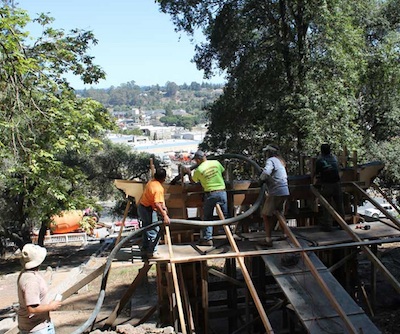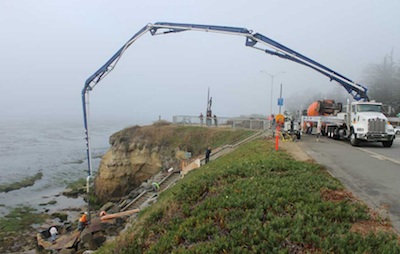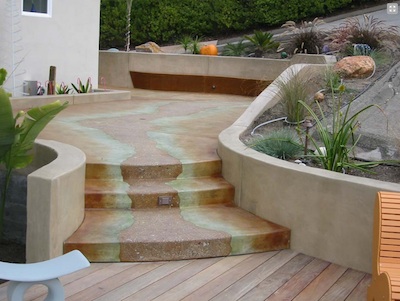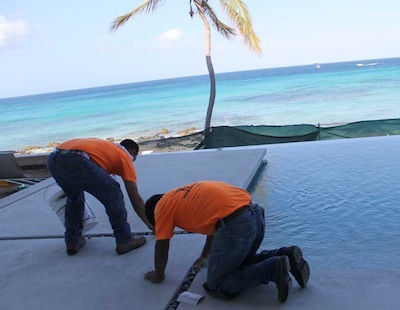In this volume Tom gives us the run down on aggregate. Everything from what its basic function is, to what kind of aggregate looks best in an exposed finish. Warning: Learning this information may lead to you becoming a concrete master.
Can you please explain what aggregate is and what is its function in a concrete mix?
 Tom Ralston: Aggregate is a term used to describe sand, gravel, crushed stone, slag, or anything like that. It is the material that is used to turn cement into concrete.
Tom Ralston: Aggregate is a term used to describe sand, gravel, crushed stone, slag, or anything like that. It is the material that is used to turn cement into concrete.
Cement placed by itself is typically very weak and will crack or craze. The aggregate is necessary, and when added it becomes concrete. So, the function of the aggregate is that it adds strength and holds everything together. It makes everything more structurally sound.
Why is larger aggregate superior to smaller aggregate (pea gravel)?
TR: The larger the rock, the more mass you have in a cubic yard of concrete. A cubic yard of concrete is 3' x 3' x 3'. So it's basically a big box. If you add aggregate that is larger it will fill up more of the box with a solid component. Thus, it will make the mix that much more structurally sound.
The shape of the rock is also important. Angular rock locks together better than round rock. Round rock really can't clasp on as tightly as an angular rock that's chipped. The chips fit together more easily and intermesh better than round rock.
We always use the larger aggregate for slabs, as large as we can fit in the mix. Typically three-quarter inch aggregate. Also, the larger aggregate means less sand, and if there's less sand there's less water needed to make it workable.
Water is a necessary evil, it allows the concrete to become supple and workable, but if you use too much of it there's a likelihood of excessive shrinkage cracking. So, if you can eliminate the smaller aggregate and increase the amount of larger aggregate you then decrease the amount of sand, thus making your mix stronger.
Is the amount of aggregate used in a mix always the same or does it vary?
 TR: Yes it varies, and the different mixes means using different equipment. Sometimes the smaller concrete pumps cannot pump a mix that's loaded with large aggregate/rock. Because it won't go through the hose. The small pumps need more cement and more sand.
TR: Yes it varies, and the different mixes means using different equipment. Sometimes the smaller concrete pumps cannot pump a mix that's loaded with large aggregate/rock. Because it won't go through the hose. The small pumps need more cement and more sand.
A grout pump will pump pea gravel and smaller aggregates easily. When you get into three-quarter inch aggregates you need a larger hose and different pump. That's called the line pump. And then when you get into a bigger pump, which is a boom pump or overhead pump, it's possible to pump mix designs that have a higher aggregate content. Tom Ralston Concrete uses an overhead pump when we're doing seamless floors with a really high aggregate amount in the concrete mix design.
Do you need to add aggregate to your mix even if you're not seeking an exposed aggregate finish?
TR: Yes, aggregates are a necessity in all concrete mixes. Even when you're not exposing the finish. Sometimes we add a special aggregate so we do not have to seed or additionally broadcast aggregates. Exposed aggregate is a whole different medium, actually an art form.
What's your go to aggregate for a project, and which one looks the best?
 TR: I love mexican pebble, I love black la paz, pammy, I'm not a fan of yuba quartz which is black and white. But we have used it and it's been done tastefully.
TR: I love mexican pebble, I love black la paz, pammy, I'm not a fan of yuba quartz which is black and white. But we have used it and it's been done tastefully.
Do different types of aggregate change the cost of a job?
TR: Absolutely. One time we used this sunburst cobble, which is bigger than fist size going down to two or three inches. Its imported from the Grand Canyon, any time aggregates have to be imported it gets very expensive. A ton can cost you $800-1200 while a typical ton can cost you $200-300. So yes, it can change the cost of the job.
Will you share a remarkable or funny story that could be relevant to this discussion?
TR: One time we had to do a client's driveway down at the Santa Cruz yacht harbor. We had to import aggregate from Arizona and make planks so we could broadcast this aggregate and place it in artful ways and positions. And It was really quite a process. Sometimes we had 20 foot planks so we could get across the expanse and drop in the aggregates to create a big vein.
Another time, we worked with an architect in Carmel named Ray Parks where we used aggregates as big as 30 inches in diameter, huge rocks that were 3-400 pounds a piece. And we placed those at the outside perimeter of the job and then we made these veins that went in and out of the deck surface. It was gorgeous, absolutely gorgeous.
What is the biggest lesson you've learned about aggregate that could help out a novice or someone just starting in the Concrete business?
 TR: One of the biggest lessons I could share is not to use pea gravel or small aggregate in flat work. Because the amount of sand used and the amount of water the pump adds to make it wet/slick enough for it to pump through does a huge disservice to the slab and usually jeopardizes its integrity and the slab ends up cracking.
TR: One of the biggest lessons I could share is not to use pea gravel or small aggregate in flat work. Because the amount of sand used and the amount of water the pump adds to make it wet/slick enough for it to pump through does a huge disservice to the slab and usually jeopardizes its integrity and the slab ends up cracking.
And I'll also warn that although the exposed aggregate finish is one of the oldest decorative concrete treatments in the 20th century it's also one of the most difficult. Don't think that doing a good exposed aggregate job is going to be easy. When we do it we have one man responsible for about 250 ft, when you start doing a really good exposed aggregate job, that calls for the aggregate to be blanketed and tightly spaced, we only figure 1 man every 90 feet. It's a huge impact on labor and hence affects cost.
Alright folks, that's it for this week's Decorative Concrete Master Q&A, join us next time for more stories and knowledge from decorative concrete master Tom Ralston. We post these Master Q&A's on the first and third Fridays of each month.
Submit your own questions here, and to find more information check out Tom's books on decorative concrete. Also, we'd love it if you'd come over and say hello on one of our social sites. Follow us or like us for more expert decorative concrete knowledge on Houzz, LinkedIn, Facebook or Instagram.
